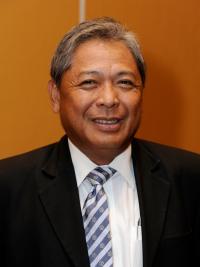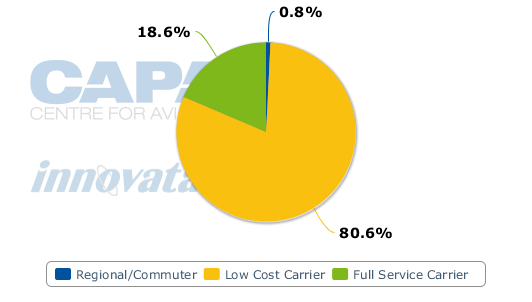Philippine Airlines plans to resume domestic expansion and looks for green light from US regulators
November 11, 2011
Philippine Airlines
(PAL) is not ready to abandon the domestic market – at least not yet.
The floundering flag carrier, which has seen its share of the Philippine
domestic steadily slip in recent years, plans to add back some domestic
capacity in 2012 as its previously-reduced A320 fleet expands again by
four aircraft.
International capacity will also be up in 2012 as PAL takes its next batch of B777-300ERs. PAL is banking on the Philippines regaining next year a Category 1 safety rating from the US FAA, which is necessary for the carrier to deploy B777-300ERs on US routes as planned. Continued restrictions on US routes is one of several challenges PAL faces as the carrier also tries to overcome increasing competition from LCCs and continuing worker protests.
International capacity will also be up in 2012 as PAL takes its next batch of B777-300ERs. PAL is banking on the Philippines regaining next year a Category 1 safety rating from the US FAA, which is necessary for the carrier to deploy B777-300ERs on US routes as planned. Continued restrictions on US routes is one of several challenges PAL faces as the carrier also tries to overcome increasing competition from LCCs and continuing worker protests.
As
CAPA reported late last month, the LCC penetration rates in the
Philippine domestic market has grown since 2005 from less than 50% to
about 80%, driven by a combination of rapid expansion by the country’s
low-cost carriers and contraction at PAL. Philippine CAB figures show
PAL accounted for only 24% of domestic passengers in 2Q2011. PAL’s share
of the market has slipped even further since late September, when a
strike was waged by ground staff employees affected by PAL’s decision to
outsource non-core functions including catering and call centre.
PAL's domestic operation has been pared back to only 60 daily flight since late September
 |
| Philippine Airlines President, Jaime Bautista |
Protests against the now implemented outsourcing plan continue, with
striking employees having taken possession of PAL’s catering facility in
Manila.
PAL was able to quickly resume its full international schedule, using
catering services from other vendors, but has not yet fully resumed its
domestic operation. PAL president Jaime Bautista told CAPA on the
sidelines of last week’s Association of Asia Pacific Airlines (AAPA) Assembly of Presidents in Seoul that the carrier is only operating 60 daily domestic flights, down from a pre-strike schedule of 140 flights per day.
Overall PAL is now operating 90% of its normal schedule, compared to
only 20% the first day of the strike and 40% on subsequent days. The 10%
of flights that remain cancelled are all domestic.
The Philippines’
three domestic LCCs have been hoping that PAL sticks permanently to the
reduced schedule, resulting in an even further increase in the LCC
penetration rate. But Mr Bautista says PAL still intends to return its
domestic schedule to the pre-strike level. He says PAL also plans to
increase its domestic schedule in 2012 as it takes delivery of four
additional A320s.
Mr Bautista says PAL currently has an A320 family fleet of 16
aircraft (12 A320s and four A319s), down from 22 aircraft a few years
ago. The smaller fleet has resulted in dramatic domestic capacity
reductions as PAL has not cut its regional international operation,
which primarily uses A320s with some routes, such as Hong Kong, utilizing widebody aircraft.
PAL and AirPhil independently expand A320 fleets
PAL’s A320 fleet has shrunk over the last two years as six A320s have been subleased to AirPhil Express,
an LCC with the same primary owner as PAL. AirPhil has been steadily
increasing its domestic operation as PAL has downsized domestically.
AirPhil, which coordinates schedules and has a limited codeshare with
PAL, plans to grow its A320 fleet from eight to 15 A320s by the end of
2012. But AirPhil is not sourcing any of its additional aircraft from
PAL.
Mr Bautista says PAL has A320 deliveries slated for next April, June,
August and November, resulting in a fleet of 20 A320 family aircraft by
the end of 2012. He says about half of the additional capacity
generated by this aircraft will be directed to the domestic market and
half will be directed to the international market.
The resulting domestic capacity expansion will be relatively modest as all three of the country’s domestic LCCs – AirPhil, Cebu Pacific and Zest Air
– are also planning significant capacity increases next year. But at
least PAL’s expansion will keep it from continuing to rapidly lose
market share and stay at or slightly above the 20% threshold
domestically.
Capacity share by carrier type in Philippines domestic market (based on seats per week for 7-Nov to 13-Nov-2011)

In addition to the four A320s, PAL has two B777-300ER deliveries
slated for 2012. Mr Bautistia says these aircraft will be delivered in
June and November. PAL currently operates two leased B777-300ERs and has
four more of the type on order with Boeing.
PAL initially committed to acquiring the six B777-300ERs in early
2008, with the anticipation of using the type to replace A340s and B747s
on its flights to the US and Canada. But so far PAL has only been able to use its initial fleet of two B777-300ERs on three weekly flights to Vancouver
as airlines from countries with Category 2 ratings are unable to add
flights to the US or change gauge on existing flights. The FAA
downgraded the Philippines from Category 1 to Category 2 only a few
months after PAL committed to acquiring the six B777-300ERs.
As CAPA reported in Jul-2011,
PAL needs the B777-300ERs to improve its product to the US and
eliminate the need for a fuel stop on westbound flights. PAL now uses
its ageing B747-400 fleet to operate daily flights to Los Angeles and San Francisco. PAL uses A340-300s to operate three weekly flights to Honolulu and four weekly Manila-Vancouver-Las Vegas flights (PAL has daily flights to Vancouver but can only use B777-300ERs on the three weekly flights that do not continue to Las Vegas because PAL is unable to operate B777-300ERs to the US).
PAL took the unusual step earlier this year to pay for a US
consulting firm to help Philippine civil aviation authorities raise
their safety standards in an attempt to meet Category 1 requirements. Mr
Bautista now says he is hopeful of an upgrade to Category 1 by
November, when PAL takes its fourth B777-300ER.
PAL banking on using B777-300ERs on US flights from 4Q2012
Mr Bautista says the upgrade to Category 1 is not necessary
before 4Q2012 because PAL plans to deploy its third B777-300ER on
flights to Australia and Japan. If
the Philippines remains in Category 2 in Nov-2012, Mr Bautista says PAL
will have to use its fourth B777-300ER on Asian routes. Clearly this is
not an ideal situation as the B777-300ERs are best suited for long-haul
routes and are significantly more efficient than the A340s and B747s
PAL now uses for its US routes. PAL has experimented with having its
B777-300ERs serve Australia, but reverted back to old schedules after
finding the capacity increase over A330s, its previous equipment, was
too much and the market wanted daily flights.
PAL is also banking on expanding its US network following the
delivery of its fifth and sixth B777-300ER in 2013. But this
is similarly contingent on Philippines returns to Category 1. As PAL
faces increasing competition from LCCs domestically and in the regional
international market, expansion of the carrier’s typically profitable US
operation could be critical to its long-term term survival.
North American routes now account for 20% of PAL's weekly seats and 45% of its weekly ASKs.
PAL international capacity (ASKs) by region, for week of Nov-7-2011 to Nov-13-2011

PAL looks to use AirPhil to better compete with Cebu on regional international flights
Within Asia, PAL will continue to expand in an effort to maintain its
market share on regional international routes. Mr Bautista says PAL
believes there is room for AirPhil, which now has a very small
international operation, to expand in the regional international market
without risk of cannibalizing PAL’s own business. He says the idea is
for AirPhil to focus on the lower end of the market, providing new
competition for Cebu Pacific, while PAL focuses on the full-service
sector.
The regional international LCC market is now dominated by PAL rival
Cebu Pacific and to a lesser extent foreign LCCs. It is also being
targeted by new local LCCs including Philippine AirAsia, which is planning to launch services in early 2012, and SEAir’s Tiger-branded A319 operation.
International expansion at AirPhil will also help AirPhil increase
utilization of its A320 fleet, thereby reducing costs. Cebu Pacific
currently enjoys a large cost advantage over the country’s smaller LCCs.
AirPhil now follows a hybrid model but Mr Bautista expects the
carrier will start pursuing a purer LCC model as it strives to lower its
costs. AirPhil’s codeshare with PAL will continue but Mr Bautista
points out that it is a one-way codeshare with PAL only selling tickets
on AirPhil’s turboprop flights. AirPhil took over PAL’s turboprop
operation in 2009, when the carrier was still known as Air Philippines and following more a legacy carrier model.
AirPhil’s fleet of Dash-8 turboprops are used to serve airfields
which cannot accommodate jets, including Caticlan – the gateway to
popular tourist destination Boracay island. The codeshare service to
Boracay and some other tourist islands is important for PAL to maintain
connections to its international network, particularly for high end
leisure passengers.
Mr Bautista said during the CEO panel discussion at last week’s AAPA
assembly that the “low cost market will continue grow in Asia-Pacific,
especially the Philippines”. The budget market in the Philippines
remains relatively untapped because only 10% of the population currently
flies.
Low costs are needed for PAL to fend off increasing competition from LCCs
As most passengers in the Philippines are budget-conscious and
competition with LCCs is already fierce, PAL also has been striving to
lower its cost structure. The outsourcing of non-core functions is an
important step for PAL as it significantly reduces headcount, which has
historically been unnecessarily high.
Mr Bautista said during last week's assembly that the continuing
protests from ground worker unions is no longer having a significant
financial impact on PAL, which is expected to report late this month its
earnings for the quarter ending 30-Sep-2011. “What’s really important
is service that is provided has been downgraded in terms of catering. We
are asking our passengers for their understanding,” Mr Bautista says.
PAL has been forced to use alternative vendors, resulting in a
decreased level of service on flights departing Manila, as it still does
not have access to its catering facility. PAL is now working with
government authorities to try to remove the striking employees so it can
regain access to its catering facility.
Mr Bautista pointed out that PAL’s plan to outsource non-core
functions was approved twice by the country’s labor secretary and twice
by president. “The problem is even with government approvals there are
many groups and institutions that are against outsourcing,” Mr Bautista
says. “It’s unfortunate we don’t get much support from our authorities.”


No comments:
Post a Comment